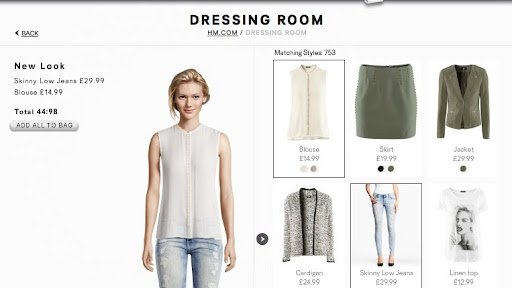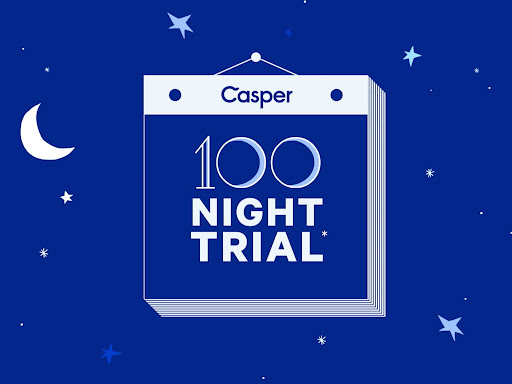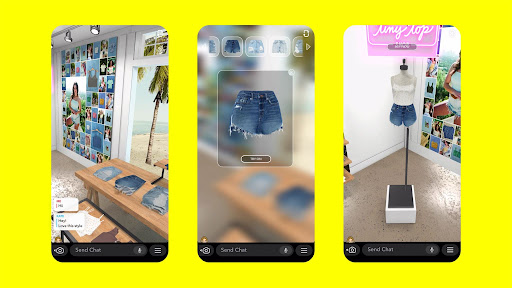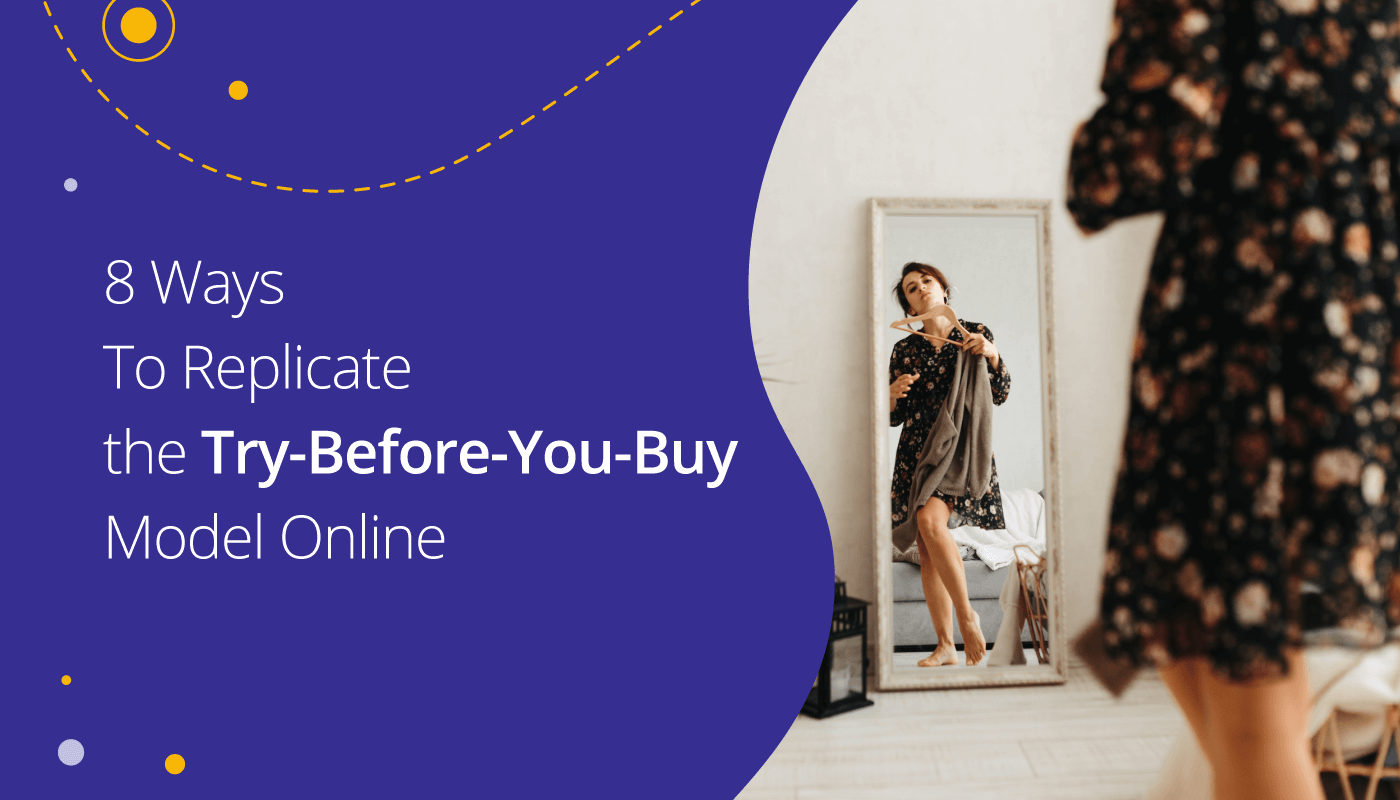Meet Andrew. ????
Andrew is the CEO of DiscountReactor, a company that helps you find the best promo codes for online shopping.
He was on the hunt for a pair of glasses with an elegant frame. His retailer of choice: Warby Parker.
Normally, he’d walk into a nearby store, try on several pairs until he found THE ONE.
But being the CEO of an eCommerce company and given how convenient online shopping is, he explored Warby Parker’s website instead.
Warby Parker has a “Home Try-On” option. You select 5 pairs of glasses, and they ship them to you for free. You can keep what you like, pay for it online, and send the rest back after your 5 day trial is up.
And that’s exactly what Andrew did. He says, “It not only improved my overall experience but made me their loyal customer.”
Warby Parker’s “Home Try-On” feature is a part of the growing try-before-you-buy trend.
PushON, a full-service digital agency focused on eCommerce, released a report on “Webrooming vs. Showrooming” and found that 82% of shoppers wanted to “view-and-touch” products before committing to buying them online.
Sam Rutley, Managing Director of PushON, explained: “It’s clear from our research that in order for shoppers to part with their money online, they must receive the same level of reassurance that they would in a brick-and-mortar store. Without the physical ability for customers to experience the tactile nature of a product or to obtain advice from a sales assistant, online retailers must provide the virtual ‘next best thing’ through the implementation of technology.”
So, how can you jump on the try-before-you-buy trend? Is it sustainable? How is it adapting? And, what do you need to get started?
We’ll cover all this and more.
Skip to the section that speaks to you!
TABLE OF CONTENTS
- What is try-before-you-buy?
- 8 Ways To Implement It + Learn From Successful Brands
- 5 Benefits of try-before-you-buy
- Will it work for you?
- Consider these Pros & Cons
- Final Thoughts
What Does Try-Before-You-Buy Mean?
Consumers can “try on” a product before they purchase it.
In the context of eCommerce, this could mean they get a feel for the product at a store before purchasing it online, buy a sample size before buying the full-size version, or get sent the product for free and only pay if they decide to keep the product.
And it’s not limited to online retail.
Streaming giants like Netflix, Hulu, Prime also offer a free trial. This is an increasingly common customer acquisition strategy for subscription-based B2C software companies.
The logistics are easier to manage when you’re not dealing with an actual physical product since you don’t have to worry about inventory management.
Major retailers like Amazon and Klarna have paved the way for the try-before-you-buy retail. What differs is how long consumers have to try on the product and return what they don’t like. Amazon Prime Wardrobe has a 7 day try-on period, while Klarna has a 30 day delayed payment window.
Why Is Try-Before-You-Buy Appealing to Consumers?
1. Delayed payment is attractive:
Since customers don’t have to pay upfront and commit to a product they’re unsure about, they are more likely to try on more products than usual. This also lowers their inhibitions about purchasing an expensive product.
Elizabeth Bramlage, head of US Marketing, Klarna, said, “Fashion fit and look can be difficult to judge from product descriptions, digital photos, and videos alone. By offering a ‘pay later’ option, consumers are finally able to bring the fitting room into their own homes and have the peace of mind that they will only ever be responsible to pay for the items they love.”
2. Poor quality or misleading online images:
According to a Weebly Survey, 75% of shoppers are influenced by product photos.
But, some e-retailers don’t bother investing in professional photography leading to pixelated or blurry images.
On the other extreme, you have websites with great product photos that look nothing like the end product customers receive. The same Weebly survey found that 22% of eCommerce returns are because of inaccurate photos.
3. Size and fit issues:
The lack of a universal sizing chart leads to a perpetual guessing game.
Winner: None.
It is a frustrating experience for consumers and retailers dealing with returns.
Take a look at this image that went viral in 2019. Chloe Martin from Glasgow photographed size 12 jeans from 5 different brands, all of which had different waist sizes.

Source: Today.com
Bizrate Insights found that 55% of consumers return their online purchases because of the wrong size. This leads to “bracketing,” a practice where consumers buy multiple sizes of the same items.
According to Narvar, a post-purchase vendor, 48% of US consumers reportedly “bracket” their purchases. But what about the rest?
- 33% don’t do it because of financial reasons
- 30% believe it’s wasteful
- 25% report that returns become a hassle
- 8% try on the product offline
Bracketing can cause inventory management issues and for online-only retailers, trying on the product offline is simply not an option.
The try-before-you-buy model along with advanced sizing technology is the way forward.
Intrigued? Learn 8 Ways You Can Implement the Try-Before-You-Buy Model From Successful Brands
No matter the size or nature of your business, there is a way you can implement the try-before-you-buy model. We’ll also look at some brands that use this model successfully and what you can learn from them.
#1. Home Try-On

Source: Klarna
The easiest way to implement the try-before-you-buy model is the home try-on. Plenty of brands like Warby Parker, ASOS, and Good American offer the option to have products delivered free or for a small deposit, but customers only pay for the items that they keep.
Peter Reimann, President, and Designer of PJR Creations, a high-end silk neckwear business is eager to implement the home try-on strategy.
Here’s why: “High-end silk neckwear purchase decisions depend heavily on physically seeing and touching the product before buying. True colors and quality are impossible to convey virtually.”
#2. Augmented Reality (AR)
It might surprise you to know that AR is not a novel concept in online retail.
Converse allowed sneakerheads to try on various shoes all the way back in 2012, but it only became mainstream in 2016 thanks to the worldwide obsession, AR-enhanced Pokemon Go.
AR can help consumers visualize what an item looks like on them or in their space.
Lowe’s, Benjamin Moore, and Wayfair have turned to AR to help consumers virtually try products. IKEA’s Place App is dedicated to letting shoppers see what the product will look like in their space.

Source: Stambol.com
But AR applications are not limited to home improvement and home decor brands.
In 2020, Bulgari, the Italian luxury brand, launched an app using AR so that clients could “try on” their Barocko high-end jewelry pieces that retail for $100,000 to $20 million.
Another interesting example in the cosmetics domain was made possible due to Google. While their VR dreams are dead, they launched an “AR Beauty Try-On feature” on YouTube. The feature allows viewers to try on different beauty products in real-time during video playback with AR.
MAC Cosmetics became the first brand to launch the AR marketing campaign with beauty influencer Roxette Arisa.

But Instagram beat Google in letting users try on virtual lipstick. In 2018, Kylie Jenner’s entire range of liquid lipsticks was available as customized filters for people to try.
We can’t talk about filters and not bring up Snap (formerly known as Snapchat). Levi’s & Snapchat celebrated Pride Month in 2019 a little differently. Snap shoppers could unlock a special Pride Lens by scanning a special QR Code that unlocked an AR experience. They could try on a trucker jacket in 2 different shades, take pictures with it and order the jacket through the app.

Source: AdWeek
While Snap has been flirting with AR eCommerce, it has cemented itself as the leader through a series of acquisitions and partnerships –
- Acquired FitAnalytics, a machine learning platform that solves sizing issues
- Acquired AR startup, Vertebrae, that enables brands to create digital 3D versions of their products
- Partnered with Verishop, a luxury eCommerce site to bring their products to Snap
Have you noticed a pattern and possibly a con of using Augmented Reality? The above examples require a brand app or need you to piggyback off a social media app.
But you don’t really need an app to activate AR experiences? You can try platforms like SeekXR, a WebAR platform built for eCommerce brands.
Source: SeekXR.com
All shoppers need to do is scan a QR Code which is a native feature on all the latest smartphones. Using the ARkit on iPhones and ARCore on Android, they can view an object in their space.
Recap: AR is great for footwear, clothing, beauty, and eyewear brands. Typically you need to build an app or rely on a social app but you can also use WebAR and a QR Code.
#3. Virtual Mannequins

Source: Gap
Imagine if you could replicate the whole experience of a fitting room online!
That’s exactly what Gap did in 2018. They used AR to power their app, The DressingRoom which allowed shoppers to try on virtual outfits on one of 5 avatars that looked like them.
Shoppers could also compare two avatars side by side and purchase the product through the app instantly.
WoWExp, takes the Avatar try-on technology a notch further. You can choose to have a 360-degree catalog and an AR catalog with or without a mannequin. The avatar created is personalized based on the inputs by the consumer and displays a true-to-size version.
Another virtual fitting rooms provider, Fits.me, creates virtual fitting rooms with robotic mannequins, and their initial research trials are very promising. They’ve achieved a 28% reduction in online apparel returns and increased sales by 3x.

Source: Fits.me
Pro Tip: A low tech high-impact version of this idea can involve photographing models of different body types and sizes to allow shoppers to visualize what it could look like on them and make an informed decision.
#4. Trial Samples
Go to a store (think Costco), and you’ll likely come back with a few free product samples.
But why do companies do this?
Product sampling works on psychologist Robert Cialdini’s Theory Of Influence. When you’re given something for free, you feel compelled to reciprocate. This explains why 35% of customers surveyed for the Product Sampling Study by Arbitron and Edison Media Research said that they would buy the sampled product in the same shopping trip.
Sampling the product first also creates customer loyalty. Event Marketer’s survey found that 65% of consumers purchase a product promoted at an event or visit, and the top reason for purchase is the ability to try it out first. Of those consumers, 58% reported that they would repurchase it.
Birchbox, a New York based online monthly beauty subscription service, is a prime example of how you can implement product sampling.

Source: BusinessInsider.com
Sign up for $15/month, and customers receive a selection of 5 deluxe products. If they chance upon a product they love, they can purchase the full-size version from their site.
Lowe’s does the same thing with their paint samples. Home owners can purchase samples to see if they like the color and return to buy more.
Some online retailers also throw in product samples for free when the value of a cart hits a certain amount. The Body Shop offers free goodies when customers shop online and they can choose what kind of samples they’d like to receive.
Another iteration of trial samples is the “starter kit”. Brickell, a men’s skincare and grooming line, offers several free starter kits and a $10 coupon towards the first purchase.
Recap: You can throw in free products or charge a fee for samples to test out new products, acquire customers and build customer loyalty.
#5. Curated boxes

Combining a personalized shopping experience and the try-before-you-buy model, a lot of clothing and accessories subscription boxes reel buyers in with an interactive quiz, pay a styling fee to have a personal stylist confer with them, and send them a curated box of items. Customers only pay for what they keep and send the rest of the items back.
Stitchfix, an online clothing company, works on this very model. I took the personalized quiz for women and it took me only 15 minutes from start to finish.

Source: Stitchfix.com
Trunk Club and Nadine West offer a similar experience.
But is having a human stylist enough? Absolutely, not.
AI provides much-needed help to human stylists by trawling through millions of outfits quickly, a feat impossible for a human.
Simon Leesley, Managing Director of Stitch Fix UK, said: “AI serves as a recommendation engine for our stylists so they can be curators rather than scroll through and pick from thousands of pieces. The algorithms understand fit nuances that humans can’t and remove any selection bias. They provide the science and our stylists provide the art.”
#6. Free Trial
Early on, we talked about how B2C software subscription companies almost always offer a free trial. The number of days ranges from 3 to 30.
It also works particularly well for Infinity Dish, a TV provider store. Laura Fuentes, Operator of Infinity Dish, says, “We started offering 30-day free trials for every new customer and have seen a substantial uptick in accounts created on our site. Our trials have virtually doubled.”
Taking a cue from the free trial model, mattress company, Casper, offers a 100 night free trial on their mattress. While Casper’s return and refund model is generous, they have been losing money on this deal because the returned mattress cannot be restocked.

So, why does Casper continue doing it?
David Perry, the editor for BedTimes and SleepSavvy, says “…mattresses are a blind purchase; you can’t look inside the mattress. One of the key differentiators in the online space is the marketing.”
Casper might benefit from a try offline buy online model or pop-up stores to reduce the return rates.
Pro Tip: Only offer a free trial on products you can restock. Have a group of beta testers review your product and use that to influence purchases and keep return rates to a minimum.
#7. “Shop with me” videos
According to TrustPilot, 9 out of 10 consumers read a review before making a purchase.
But featuring a review on your website is not good enough. Only 1 in 5 consumers trust the reviews on your website. Sure enough, you can collect reviews on Google but what if there’s a much better mousetrap?
This Think With Google article explored the try-before-you-buy mindset and found that people increasingly turned to creators that create “Shop with me” videos.
Check out the rise in searches worldwide in 2020 compared to 2019. The term “come shop with me” has had a 40% increase globally.

You can see this happen with makeup, luxury cars, shopping trips to a store, and detailed product reviews of online goods.
Use the beta tester idea and invite a focus group to try your products for free and leave an unbiased review of your product on YouTube.
#8. Rent before you buy
Rent before you buy works particularly well for expensive items, especially electronics. Best Buy tested out a version of the “rent before you buy” model in 2017. Customers were able to test out expensive equipment without the commitment and Best Buy could reuse open box items.

This model also works for clothing companies that rent designer goods to see whether you’d like to make a purchase eventually. Rent the Runway charges a subscription fee for the monthly rental and offers members first dibs on all designer items.
Pro Tip: This strategy does not work with all kinds of items. Electronics, cars, designer clothing, and jewelry are more suited to this model.
5 Benefits of the Try-before-you-buy Marketing Strategy
#1. Acquire New Customers
By offering a no-risk commitment to new customers, you can expand your reach and become the preferred online store.
According to Klarna’s national study, “71 percent of respondents stated they would be moderately, very or completely likely to choose a retailer offering a try-before-you-buy option over one who did not offer this option.”
Amir Behrozi, the founder of My Home Dojo, a product review site, was able to try the Samsung Galaxy as soon as it was released. He says, “I know that it definitely made me more comfortable when purchasing my new Galaxy phone because I had tried mine out first ahead of time without any commitment whatsoever.”
#2. Boost Sales & Loyalty
The same Klarna study found that 69 percent of consumers would be moderately, very, or entirely likely to buy more items from online merchants offering this payment option.
Keith Eneix, President of TautUSA, a beauty brand specializing in Collagen, recently implemented a try-before-you-buy marketing strategy in their business.
For a new beauty brand to go up against established brands, this has been critical. “Our main strategy involved letting customers try products before investing in them. The progress was slow at first since we evaluated that customers need time to decide on the product’s authenticity. But, over the months we have seen an increase of almost 28% in our sales, the revenue generated is 3 times more than last year.”
#3. Soft Launch a New Product
Clayton Christensen, Harvard Business School professor, said that there are 30,000 new products introduced each year and a whopping 95% of them fail. Combining the product sampling or rent before you buy with a QR Code can help you gain instant feedback. Place the QR Code on the primary product packaging and incentivize scanning it to share quick feedback at regular intervals.
Keeon Yazdani, Chief Marketing Officer at Elevate Delta 8, a DTC brand that manufactures hemp-derived gummies, tried the try-before-you-buy marketing strategy for B2C and B2B sales.
“Our gummies are packaged in jars that contain 35 pieces. To implement a try-before-you-buy strategy, we created a foil pack packaging design that contained only 2 gummies for sample purposes. The foil pack packaging design is very similar to the Eclipse gum packaging that everyone is familiar with. This strategy worked very well because consumers were able to try our product before committing to a purchase online, and it also helped brick and mortar stores receive feedback on our product before they committed to a wholesale order.”
The result?
They were able to receive 150 wholesale orders and their online retail sales grew by 40% due to the positive feedback and the brand recognition they built.
#4. Have Competitive Advantage
Even though Casper is losing money, the competitive advantage they’ve gained through their 100-night free trial model is evident when you look at their market share. Casper has the largest market share in the online mattress industry.

Source: Statista
#5. Reduce Return Rates
The use of AI and sizing technology coupled with a try-before-you-buy model can help reduce return rates. But for this to work, you need a transparent return policy, automation in place, or partnership with companies like HappyReturns that facilitate a buy online, return to store model, and an in-depth analysis of your returns data.
Will Try-before-you-buy Work for You?
Ask yourself these 4 questions to determine whether try-before-you-buy makes sense for your online store.
Does it make sense for my industry?
According to Statista, here are the most popular items that consumers in the UK want to try before buying them. 
Source: Statista
Sara Feldstein, Founder of Barumba Play, a brand-new eCommerce toy company, briefly ran a try-before-you-buy program that failed.
It started with families signing up to be toy testers during the product development stage. These families became huge supporters of the brand and made a purchase.
When people continued to reach out to them to try their product before they committed, they decided to give the try-before-you-buy a shot.
“The problem was that it seemed to attract the wrong people – It was people who had no intention of purchasing our product but wanted to keep their kids busy for a few days when schools were closed. The people who saw and wanted our product just bought it.
I also think we were robbing these families of the excitement of having a new toy. By trying our product out, the thrill was gone, and they didn’t feel the need to purchase it. It’s like getting a free piece of cake and then being asked if you would like to pay to eat a second slice. You may have loved the cake, but the first excitement you had about the cake is gone, and you don’t really want it anymore.”
Are the products durable to make it through the ship-try-return journey?
Fragile items like glassware, handmade goods or ceramics may not be the right fit for the try-before-you-buy model.
Do I have return delivery figured out?
This is where most companies lose money. Retail giants like Amazon can offer free returns due to their robust logistics infrastructure. If you don’t have a scalable system, this may not be for you.
Do I have systems in place to extend this offer?
Try-before-you-buy requires automation and sometimes complicated technology to be in place for it to work seamlessly. If you’re just starting, try low-tech strategies like video marketing.
Consider These Pros & Cons
| Pros | Cons |
| Convenient for customers | Can be a logistical nightmare |
| Experiential shopping experience | Can cause Inventory management hiccups |
| Increases sales and profits | Can cause cash flow problems |
Final Thoughts
Try-before-you-buy is all set to become the future of eCommerce.
TryNow, a San Francisco based startup that offers tech to enable try-before-you-buy for retailers that use Shopify Plus, just raised $12 million, a sign of the times. According to TryNow, brands “using its service see their average order value grow by 63%, conversion rates by 22% and return on ad spend by 76%.”
Inspired by Stitch Fix, other smaller DTC brands like Gemist and Nordgreen are investing in building out their home try-on model. Madeline Fraser, founder, and CEO of Gemist, a jewelry brand, envisions Gemist becoming the Warby Parker of jewelry.

Source: Bloomberg.com
And, with Snap and YouTube making enormous strides towards immersive content through augmented reality, expect the gap between the digital and physical worlds to become blurred.
Kickstart your try-before-you-buy strategy by preventing cart abandonment with Vital’s Shipping Information that lets shoppers know the exact shipping time and cost. Free for 30 days.


0 Comments